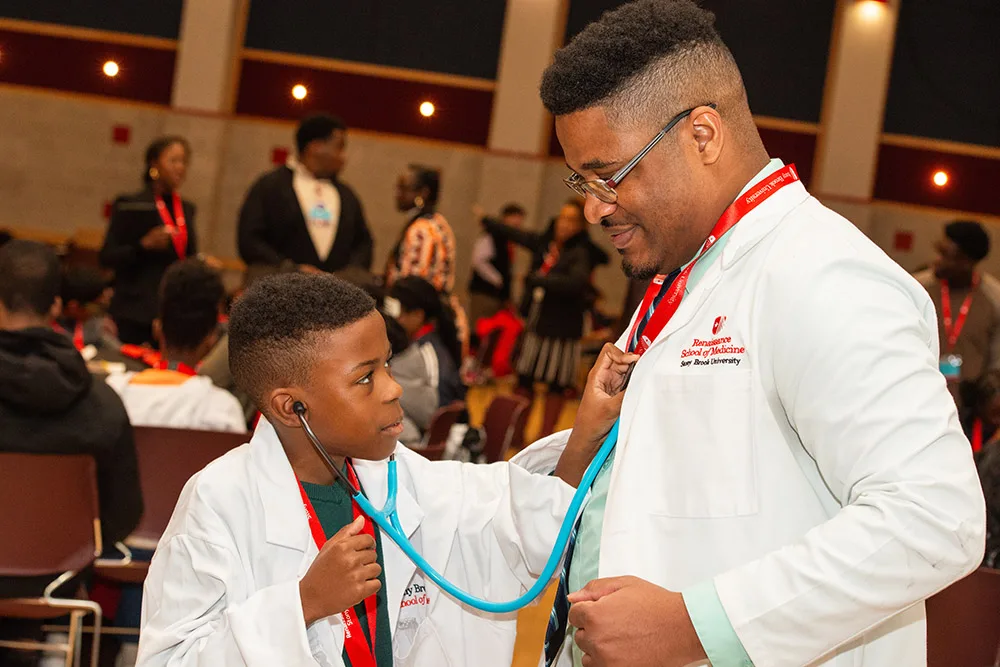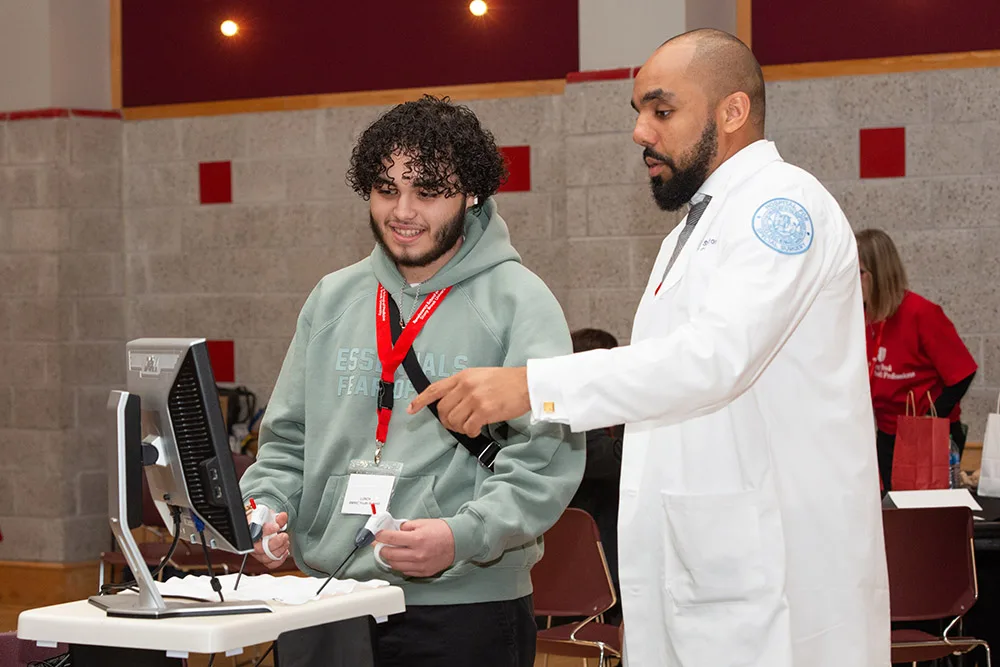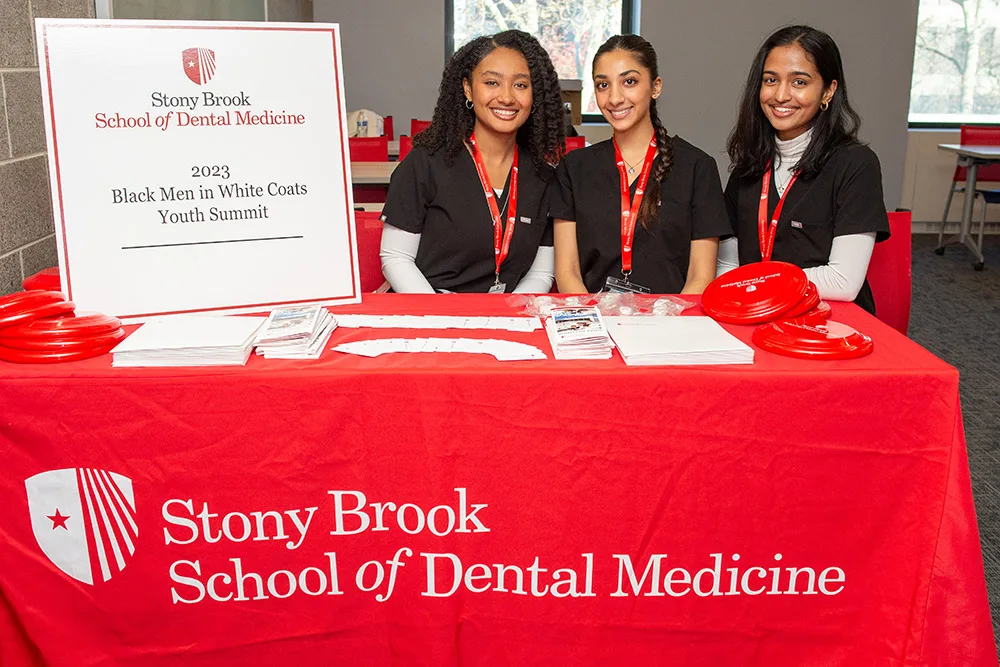
The medical field has historically faced challenges in achieving representation and diversity, particularly among Black men. Recognizing this disparity, the organization Black Men in White Coats was founded in 2013 with a mission to address the underrepresentation of Black men in medicine and to work toward reshaping the face — and color — of healthcare.
On November 16, the Renaissance School of Medicine in collaboration with Stony Brook’s Black Men in White Coats chapter — the first on Long Island — hosted more than 500 3rd through 12th grade students, educators, parents, college students, healthcare professionals and community leaders from across Suffolk, Nassau and New York City for Stony Brook’s inaugural Black Men in White Coats Youth Summit.
The Summit, funded by the Renaissance School of Medicine and the University and Hospital Community Relations Office, was free to attend, and was staffed by over 100 faculty, staff and student volunteers.

Dean of the Renaissance School of Medicine Peter Igarashi, MD, welcomed the crowd and described the necessity of increasing diversity in healthcare. “What we’ve learned over the years is that the earlier people get introduced to health care careers, the more likely it is that they will enter healthcare careers,” he said. “The most important goal today is to promote a diverse healthcare workforce, and the reason for that is that very diverse healthcare teams outperform teams that are not as diverse.”
“If we aspire to produce excellent health care for our communities, then we want to have a diverse workforce,” Igarashi added. “And the outcomes of our patients are better if the physician workforce and the other health care workforce is more diverse, and for these reasons, we’re absolutely committed to this as a goal and that is the reason why the Stony Brook Black Men in White Coats chapter was launched in 2022.”
Suffolk County Commissioner of Health Gregson Pigott, MD, spoke about his own experiences as a minority in healthcare and recounted a recent instance when his mother was treated by a high number of Black people in positions throughout the hospital.

“They’re all people of color and it just felt that it was like being about family,” Pigott said. “It was like being in a hospital and knowing that these folks have your back. It’s important to say that representation matters in all aspects of health care for all aspects of this field.”
Pigott’s experience echoes national trends, which show that individuals are more likely to go to the doctor and to be honest about their health concerns if their doctor is the same race, yet Black patients often have difficulty finding a physician of the same race.
High school students attended workshops to learn about financial aid, admissions, the School of Dental Medicine, the Renaissance School of Medicine, the School of Health Professions, the School of Nursing, and the School of Social Welfare.
Elementary and middle school students participated in hands-on activities related to medical fields (later visited by the high school students). Some of the most popular hands-on activities were the robotic surgery machine, where students were able to pick up small plastic objects with robotic hands to simulate a surgical operation, and ultrasound machines, where students were able to use the machines on one another to locate and view the carotid artery, veins and muscles.

“With this age group, if you are not engaging or entertaining, you’re going to lose them. Today, we haven’t lost one of them,” said Anthony Giambrone, a fifth-grade teacher at Martin Luther King, Jr. Elementary School in Wyandanch. “So they’re definitely engaged for sure. It’s also great because the people in white coats are all people of color and all our students are people of color. So they’re seeing themselves in these professions and hopefully, it will inspire them to see that they can work in these professions.”
The Summit concluded with remarks from Brian Harper, MD, New York Institute of Technology’s vice president for equity and inclusion and chief medical officer, who recalled the health resource inequities he has witnessed while working in underserved communities.
Harper was inspired to enter healthcare by his dermatologist, who was one of only six Black dermatologists in the country at the time. While an undergraduate and in medical school, Harper encountered faculty who gave him poor advice and were unwilling to work with him in the classroom. The message: there will be those who try to put up roadblocks on your path to success. Prove them wrong.
Raymond Uduba, second-year medical student in the Renaissance School of Medicine and president of the Stony Brook chapter of Black Men in White Coats, reflected on the importance of the event. “This is a good opportunity for young Black and Brown people to kind of get a feel for what the medical field is, and we also have medical students like me who are not in the field yet but have some insight about how to get into the field,” he said. “I’m excited for the kids to get hands-on experiences to see what it is like working in a medical profession, and to see people who look like them working in medicine.”
— Beth Squire

